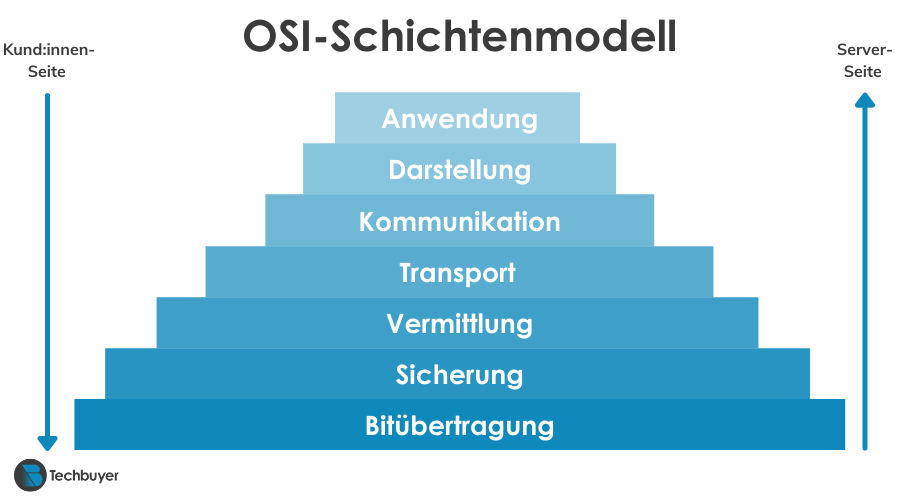The OSI model
The Open Systems Interconnection (OSI) model maps how different computer systems can communicate with one another. It was published by the International Organization for Standardization in 1980 to enable data exchange between devices from different manufacturers. Read on for our explanations of the model and illustrations of how it reflects the work of an internet provider.
The rules and standards set out in the OSI model define the basis for communication and data exchange between different systems. They are not fixed standards, however. Rather, they provide a basic structure for the design. The OSI model is a reference model that illustrates which processes have to be organized for network communication, but it does not specify how these processes need to be organized.
The OSI model splits network communication into seven layers. Certain tasks must be performed at each layer when two systems communicate with one another. During this process, data passes through all seven layers at least once at both the sending device’s and the receiving device’s end.
The layers are split into two groups: layers 1 to 4 are transport-focused layers, and layers 5 to 7 are application-focused layers.

OSI layer 7: the application layer
Data input and output takes place at the top layer. Behind the scenes of the applications, the data is transmitted to the presentation layer in the form of data packets.
OSI layer 6: the presentation layer
The presentation layer defines how the data will be displayed. The data is converted into standard formats to ensure it can be read by the application layer.
OSI layer 5: the session layer
The main function of the session layer is to set up, coordinate and terminate connections (sessions) between sending devices and receiving devices. Checkpoints are defined so that there is no need to restart data transmission from scratch if the connection fails or if problems occur at the lower layers. Once the connection is re-established, the session can be resumed from the last checkpoint.
OSI layer 4: the transport layer
The transport layer is the link between the application-focused and transport-focused layers. This is where the data is taken from layer 5 and converted into a format suitable for transfer. Layer 4 is responsible for ensuring that the data reaches the receiving device in the correct order. It also defines how to fix relevant errors.
OSI layer 3: the network layer
The network layer defines the path the data takes from the sending device to the receiving device through the network (routing). The data is broken up into packets. Information needed for the transmission is added to these packets. The data is reassembled again on the receiving device. In addition, transmission errors are diagnosed and fixed at layer 3.
OSI layer 2: the data link layer
At layer 2, the data packets are converted into a bitstream (a string of zeros and ones) to enable transmission. The bits are broken down into frames. Control information, addresses and checksums are added to them. The data link layer defines how the bits arrive at the destination in the correct order and how errors can be detected and prevented.
OSI layer 1: the physical layer
This layer includes the physical components involved in communication, such as cables, connectors, computer racks and cable ducts, not to mention the power supply. Basic elements such as the network topology and the transmission medium used are defined too.
The OSI model from the perspective of an internet provider
The service that internet providers offer their customers can be very precisely mapped using the OSI model. So it is expedient for public authorities, such as the Swiss Federal Council in its recently published Federal Strategy for a Very High Capacity Network, to take this approach too.
The core tasks of an internet provider are mainly at transport-focused layers (i.e. 1 to 4).
OSI Layer 1
The activities involved in the construction of the fiber-optic network – i.e. civil engineering, laying the ducts, cable pulling, splicing the fiber-optic cables and providing the connections on the OTO socket and at the connection point on fiber-optic distribution boxes – belong to layer 1. The investment required to build layer 1 is comparatively high, but its operation is relatively cost-effective because fiber-optic cables are practically maintenance-free. The amortization and interest, and sometimes also the leasing costs for ducts, are virtually the only operating costs incurred for layer 1.
OSI Layer 2
Layer 2 consists of the electronics installed at the connection point (PoP). Nowadays, layer 2 is mostly operated as an Ethernet connection by means of Ethernet switches. Layer 2 also, at least in part, includes the end customer’s router because it handles data transmission from a to b (i.e. between two defined points).
OSI Layer 3
Layer 3, on the other hand, handles the data transfer from a to n (i.e. from the end customer to any server anywhere in the world). Although the end customer’s router also has a layer 3 function, it usually only has one destination (i.e. the provider’s infrastructure). The functions abstracted from layers 2 and 3 are intermingled in network devices such as switches and routers, since almost all of the devices available nowadays can transfer data from a to b, as well as from a to n.
OSI Layer 4
Management of layer 3 can be correlated to layer 4. This includes the BGP4 routing protocol, which is used to exchange cross-provider routing information between providers to enable the interconnection between different providers to work in the first place.
Investment and expertise
We are sometimes accused of being freeloaders because we do not operate our own fiber-optic network. We respond to this untrue charge by pointing out that the investments in layer 1 and layers 2/3 roughly balance out over the service life of 30 years.
As mentioned above, the investment costs for layer 1 are comparatively high. However, the infrastructure of layer 2 and layer 3 has a significantly shorter lifespan and needs to be replaced approximately every 10 years, while layer 1 generates maintenance-free yields once it has been set up. The one-time investments in layer 1 and the three-fold investments in layers 2 and 3 for operation over 30 years are about the same.
Building a fiber-optic network is one thing. Running a fiber-optic network is something else entirely. Both require specific know-how and expertise. So it makes sense for companies to focus on what they do best. Nobody expects a civil engineer to run a provider network, just as they do not expect a network engineer to pull a cable.
Wholesale and retail markets
The OSI model can also be used to separate the telecommunication industry’s wholesale and retail markets. Several court rulings in recent years are based on this segregation, such as the ruling of the Federal Administrative Court in October 2021 on the “fiber-optics dispute”.
Swiss lawmakers explicitly want a free retail market in the telecommunications sector. The retail market (i.e. the internet subscriptions that the various providers offer) can be correlated to layer 3. For this to be successful, all market providers must be subject to fair conditions in the wholesale market (i.e. in the lower layers (1 and 2)).
OSI Layer 1
The layer 1 wholesale product is based on the dark fiber that internet providers can lease from network operators. It is marketed by Swisscom as Access Line Optical (ALO), and by various municipal utilities and Swiss Fibre Net as Fibre Local Loop (FLL). Technically speaking, ALO and FLL are identical – the dark fiber between the end customer and the connection point.
To be able to use the layer 1 wholesale product as a provider, you have to invest in your own electronics at the connection points. We do this by installing more of our Fiber7 PoPs at numerous locations.
OSI Layer 2
Swisscom’s Broadband Connectivity Service (BBCS) is the layer 2 wholesale product that provides the point-to-point connection between the end customer and the provider. (The fact that BBCS is structured technically as layer 3 is not important at this point.) Other layer 2 wholesale products include the likes of ewz.zürinet and LiteXchange.
They are transport services that connect customers to a provider’s network. These layer 2 services are based on layer 1. Each is a “lit fiber” because the wholesale supplier operates the necessary electronics.
Discrimination on the wholesale market
For providers with their own infrastructure who only lease the dark fiber, value creation begins at layer 2, while for BBCS resellers it only begins at layer 3. So it would actually be logical if the layer 1 wholesale product were cheaper to purchase than the layer 2 one. But this is not yet the case everywhere and is currently under judicial review.
It is the legislator’s stated intention to ensure unimpeded competition on the retail market. So it goes without saying that a provider that only purchases layer 1 externally and operates layer 2 itself should also pay significantly less for the wholesale product than a provider that purchases a layer 2 wholesale product.
